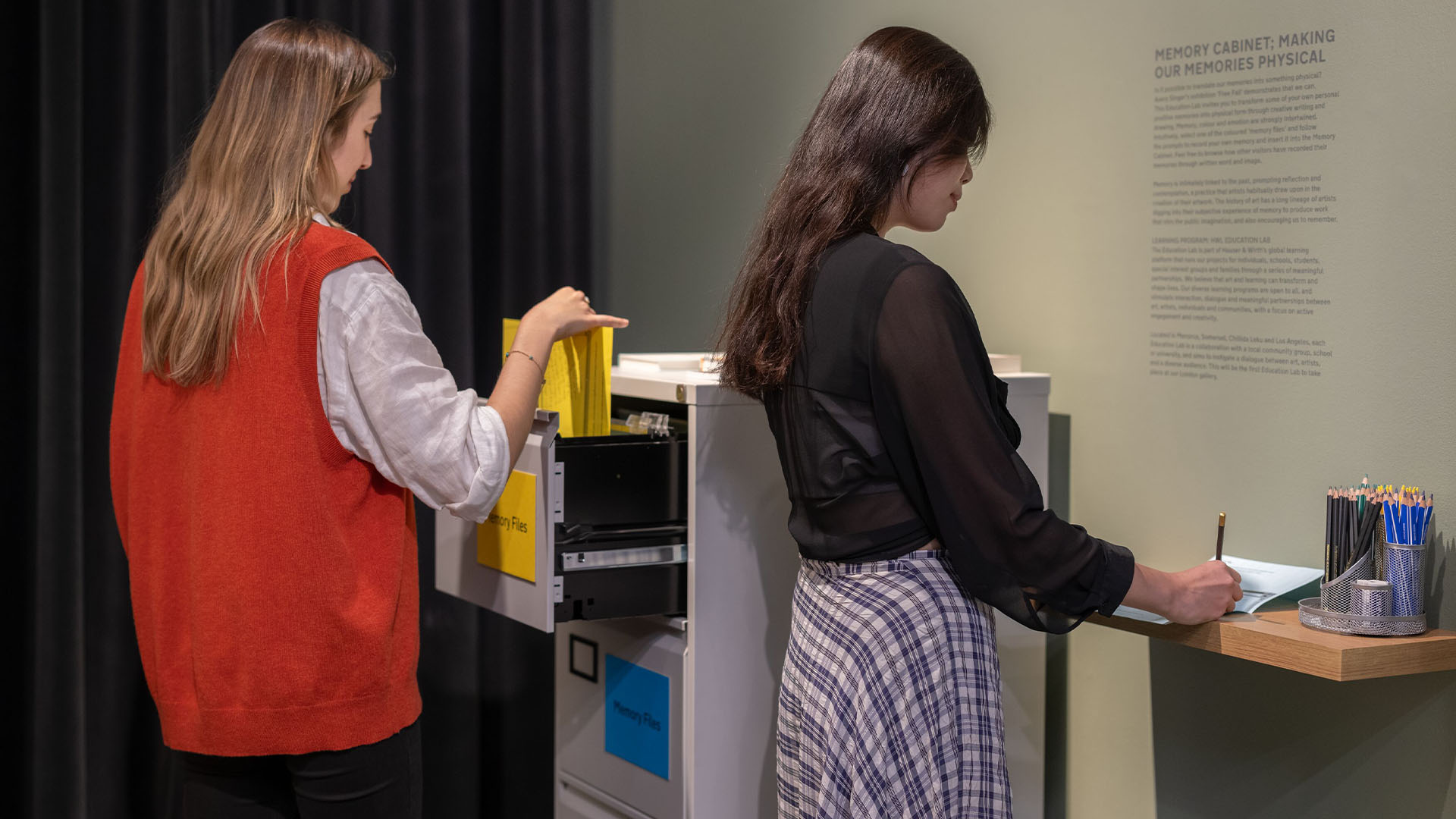Education Lab Comes to London: ‘Memory Cabinet—Making Our Memories Physical’

Installation view, Education Lab: ‘Memory Cabinet – Making Our Memories Physical,’ Hauser & Wirth London, 2023. Photo: Damian Griffiths
Education Lab Comes to London: ‘Memory Cabinet—Making Our Memories Physical’
Avery Singer’s exhibition ‘Free Fall’ offers an exciting opportunity for Hauser & Wirth London to host its first pop-up Education Lab instigating a dialogue between the contents and themes of Singer’s exhibition and a diverse visiting audience.
‘Memory Cabinet’ will explore the theme of memory with our visiting audiences and existing learning partners this fall. The traumatic events and associated memories 9/11 are both personal to Singer and history-making at the same time. In response to the exhibition, ‘Memory Cabinet’ prompts visitors to reflect on their own personal and collective memories, as well as consider how artists can transform memories into something physical. Using the exhibition ‘Free Fall’ as a springboard, the Education Lab encourages participants to consider the interconnection of memory, emotion and color in the act of creation through their own writings and drawings.
Opening from Tuesday 10 October until Friday 22 December 2023, visitors will be able to leave their own creative responses in the ‘Memory Cabinet’ during the gallery’s opening hours from Tuesday to Saturday between 10 am and 6 pm.
‘We are delighted that Avery Singer has embraced the value of our Learning program and supported an Education Lab at our London gallery that provides a platform for us to engage with the widest possible audiences.’—Debbie Hillyerd, Senior Director, Learning
The Education Lab is part of Hauser & Wirth’s commitment to inclusive learning programs that instigate a dialogue between art, artists and diverse audiences. Located at our galleries in Downtown Los Angeles, Menorca and Somerset, as well as the Chillida Leku museum, each Education Lab is a collaboration with a local community group, school or university. The interactive spaces take their starting point from one of our international artists, facilitating a platform for discovery, discussion and additional resources.
In addition to the Education Lab, our London gallery’s learning program includes a range of events running in conjunction with the exhibition from October to December. This includes drop-in interactive recordings as part of The Big Draw Festival 2023, an educator preview evening and a discursive ‘Painters on Painting’ workshop, in which artists and tutors will facilitate a conversation with university students around Singer’s practice.

Installation view, Education Lab: ‘Memory Cabinet – Making Our Memories Physical,’ Hauser & Wirth London, 2023. Photo: Damian Griffiths
About ‘Avery Singer. Free Fall’
In the exhibition ‘Free Fall’, Singer’s reflects upon her personal experience of the 9/11 terrorist attacks on the World Trade Center in New York City and explores the wider societal impact of collective trauma and proliferating image culture and media dissemination. Based entirely upon Singer’s childhood memories, the works and architectural intervention in ‘Free Fall’ are a testament to the power of memory—and a memorial to a moment of terror and survival. This is the artist’s first solo exhibition in the UK.
About Avery Singer
Avery Singer was born and raised in New York NY. Growing up in a creative community, Singer experimented with photography, film and drawing, but in those years never considered working with paint. In 2008, Singer studied at the Städelschule, Frankfurt am Main, and in 2010, she received her B.F.A. from Cooper Union, New York NY. During her studies, Singer engaged in performance art, video making, as well as sculpture utilizing carpentry, metal casting and welding. After graduation, she discovered her chosen art form from an unanticipated experiment with SketchUp, a program used by her peers to design exhibition spaces and airbrushed a black-and-white painting based on a digital illustration. Since then, Singer has employed the binary language of computer programs and industrial materials in order to remove the trace of the artist’s hand while engaging the tradition of painting and the legacy of modernism.
Related News
1 / 5




